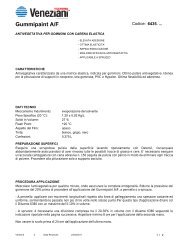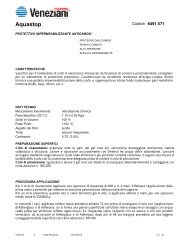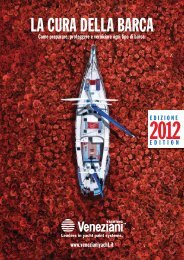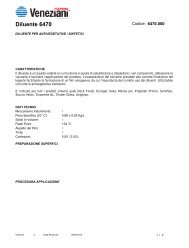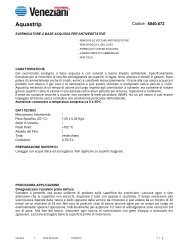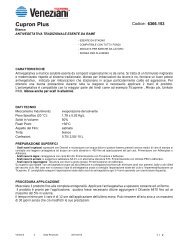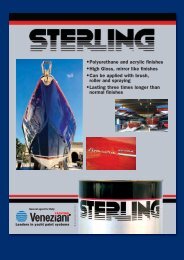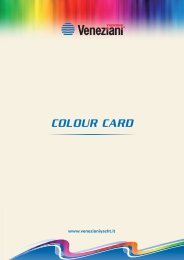3 - Veneziani Yacht Paints
3 - Veneziani Yacht Paints
3 - Veneziani Yacht Paints
Create successful ePaper yourself
Turn your PDF publications into a flip-book with our unique Google optimized e-Paper software.
1 PAINTS<br />
6<br />
Safety and hygiene<br />
These basic safety and hygiene rules<br />
must be obeyed whenever you<br />
are using paint.<br />
• Carefully read the instructions<br />
printed on the can before starting<br />
to paint.<br />
• In particular, check the safety label<br />
for the precautions which must<br />
be taken for each product.<br />
• Certain paint ingredients (particularly<br />
in antifouling) are irritant if<br />
touched, noxious if inhaled and sometimes<br />
are toxic.<br />
These dangers, which vary from<br />
6487...<br />
product to product, are clearly indicated<br />
on the safety label by the appropriate<br />
symbols and with the relevant<br />
precautions.<br />
• Do not smoke when painting.<br />
• Almost all paints contain inflammable<br />
solvents which evaporate<br />
during drying. Be careful not to<br />
inhale the vapours, especially in a<br />
closed environment. Ensure adequate<br />
ventilation to avoid the accumulation<br />
of vapours and the risk of<br />
fire or explosion and use an appropriate<br />
mask.<br />
• Always wear gloves, a mask and<br />
protective goggles.<br />
• Always sand with wet sandpaper<br />
on a wet surface, particularly with<br />
antifouling, and wear gloves, a mask<br />
and protective goggles.<br />
• Use the water-based paint stripper<br />
AQUASTRIP to remove old<br />
paint. Dry sand or use a heat stripper<br />
only where it is impossible to<br />
use another method.<br />
• When you have finished, or during<br />
breaks for refreshment, thoroughly<br />
wash your hands with soap<br />
and water or with a hand cleansing<br />
agent. Never use thinners or strippers<br />
based on solvents to wash<br />
your hands.<br />
<strong>Veneziani</strong> labels comply with EEC regulations incorporated into Italian legislation regarding dangerous products and materials.<br />
Main danger symbol<br />
Easily<br />
inflammable<br />
F<br />
Highly<br />
inflammable<br />
F+<br />
Batch number<br />
Toxic<br />
Istruction for use<br />
Bar code Tactile<br />
instructions<br />
Product code<br />
for blind people<br />
T<br />
Highly<br />
toxic<br />
T+<br />
Noxious<br />
Xn<br />
Irritant<br />
Xi<br />
Corrosive<br />
C<br />
Harmful to<br />
environment<br />
N<br />
Colours which identify<br />
the various groups of<br />
<strong>Veneziani</strong> products.<br />
For example:<br />
RED = antifouling<br />
INFLAMMABLE: products which can burst into flames when brought into<br />
contact with air at a normal temperature; or which can be easily ignited and<br />
which will continue to burn when the source of ignition is removed.<br />
TOXIC: products which can acutely and chronically affect health, even causing<br />
death, if they are inhaled, ingested or allowed to penetrate the skin.<br />
NOXIOUS: products which carry limited risks to health if inhaled, ingested<br />
or allowed to penetrate the skin.<br />
CORROSIVE: products which can have a destructive effect if placed in contact<br />
with living tissue.<br />
IRRITANT: products which, while not being corrosive, can have an inflammatory<br />
effect on skin and tissue if placed in immediate, prolonged or repeated<br />
contact.<br />
HARMFUL TO ENVIRONMENT: products which in the long term may cause<br />
environmental pollution.<br />
Product name<br />
Safety warnings:<br />
1) Potentially hazardous<br />
components<br />
2) Instructions to be<br />
followed according to<br />
European standards.<br />
Trade name<br />
and manufacturer’s<br />
address




